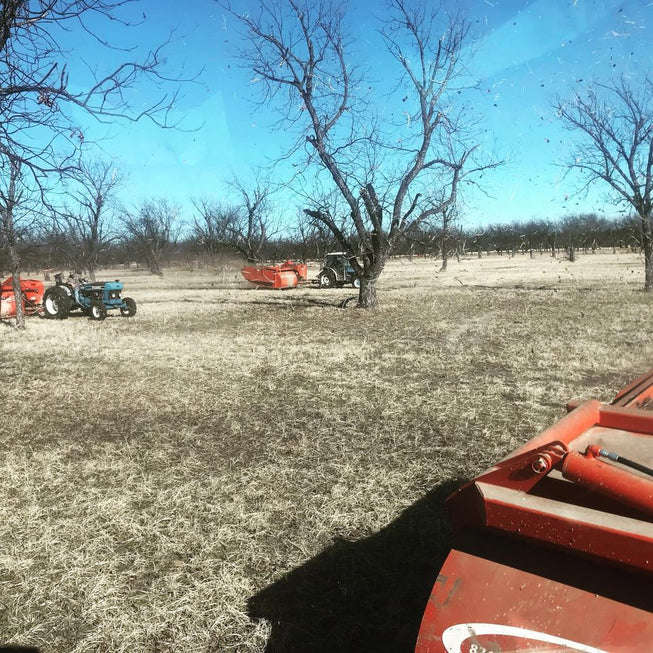
TOM E.DENMAN
Associate Horticulturist, West Cross limbers Experiment Station
Stephenville, Texas
WITH AN OPENING PRICE of 12-14 cents per pound for pecans and an extreme shortage of labor early in the season, it appeared for a while that much of the 1965 native pecan crop might not be gathered.
Later, as the price advanced and labor became more plentiful, there was a scramble to get the pecan crop out before weather became unfavorable for harvesting.
Due to the extremely mild weather in early winter a thick mat of vegetation completely covered the fallen nuts in many orchards before harvest began. Thousands of pounds of pecans remain buried under this grass where it was impractical to gather them.
Losses from the delayed harvest this past season were of great concern to pecan growers and the need for mechanical harvesting is becoming more urgent every year.
After working with the many problems involved in the mechanization of pecan harvesting for the past few years, it now seems likely that a standard procedure suitable for all orchards will not be developed soon.
Rather, it seems more likely that a number of machines useful under various orchard conditions will become available. Growers will have to determine their individual needs.
Meanwhile, the Texas Experiment Station has been working on a summer of pieces of equipment that might prove useful to pecan growers.
Results of some preliminary work on mechanical separators and cleaners for machine harvested nuts clearly indicate the need for more thorough ground preparation of the orchard sites prior to harvest. Large quantities of immature nuts, short sticks and other trash about the size and shape of pecans ran through the various cleaning units and had to be separated from the pecans before they were ready for market.
In the preparation of the ground for mechanical harvesting, a modified dump rake seemed promising. The rake was completely dismantled saving only the tines and angle iron frame. After doubling the number of tines, the rake was adapted to a three-point hitch. The steps in altering a dump rake are:
1. Completely dismantle rake saving only the angle iron frame that holds the tines.
2. Remove all tines and turn angle iron frame completely over.
3. Weld double the original number of tines to angle frame spacing tines evenly along frame.
4. Cut open slots in another piece of angle iron that will match spacing of tines.
5. Bolt second piece of iron to frame in order to hold tines securely in place
6. Attach hitch pins for lower lift arms to front side of angle frame.
7. Weld two pieces of angle iron under frame and extending about 16 inches forward to provide several openings so upper arm link can be properly adjusted.
8. Note that upper arm link actually pushes downward as rake is lifted.
9. Weld light metal shield to end tines to prevent trash from dropping out of rake.
With the rake it was possible to clear most of the leaves, sticks and other trash from the orchard. The larger limbs were picked up by hand prior to this operation. The faulty pecans and some of the smaller material remained on the ground.
This simple unit can be constructed with very little expense and should serve a useful purpose in cleaning up a pecan grove just before harvest. It would greatly reduce the amount of bulky material to be handled by any kind of harvesting unit, thus speeding up the harvesting operation. In late winter, after completion of harvest, the accumulated trash could be removed from the orchard to promote the growth of a better sod cover necessary for efficient use of mechanical harvesting equipment.
Many pecan growers have suggested that it would be more practical to retrieve the pecans with a simple pickup device that removed only the bulky trash and leaves. Further cleaning might be completed in the orchard with a machine designed especially for this purpose. Finally, the remaining small trash and faulty pecans would be removed at the shed as the pecans were prepared for market.
A number of drum-type and shaker-type units have been evaluated during the past 3 years, in an attempt to find the most efficient device for handling pecans containing large quantities of trash. Various types of screens, blowers and shaking devices were evaluated.
An obsolete Lilliston peanut picker seemed especially promising after certain modifications. Much of the bulky equipment used to handle peanuts was removed, and two screens were installed to separate the nuts from the trash. The operation of this unit is as follows:
1. Nuts and trash are dumped near ground level into a large hopper.
2. Material is transported up a canvas conveyor belt---40 inches in width.
3. Material drops from belt into airstream created by heavy duty blower.
4. All of the leaves and much of the lighter trash are removed in this operation.
5. Pecans and heavy trash fall on to sloping shaker screen.
6. Pecans and heavy trash drop through openings in metal screen and large trash drops off the end.
7. Pecans and small trash drop on sloping rod screen with a . shaking device.
8. Pecans travel down screen and drop into a dump chute. Small sticks drop through rods onto ground.
A large quantity of bulky trash and leaves were run through this machine when pecans were harvested with a trash sweeper which swept the ground clean. It was possible to separate a total of 789 pounds of pecans in 2 hours. This method of harvesting would be too slow for field operation but it did reveal the enormous capacity of the machine to handle bulky trash.
In another test, large sheets were used in early-season harvesting of pecans in areas where mechanical harvesting did not seem practical. After the nuts were shaken from the trees, the larger limbs were removed from the sheets and the remaining material was loaded onto a pickup and transported to the separator. The machine removed all of the leaves and larger sticks but it did not remove the pecans with adhering husks and small sticks about the size and shape of a pecan. The pecans were allowed to dry about 2 weeks and were then rerun through the separator, thus eliminating many of the husks. The capacity of the machine to handle pecans in this manner was limited only by the time required to shake and collect the nuts on the sheets.
Total cost of harvesting pecans on sheets is as follows:
Man Hours cleaner Conveyor belt
Spreading sheets and dumping .......14
Running through cleaner ..................4 2
Rerunning through cleaner ...............1 ½
Running nuts over belt ......................5 1
---------------------------------------------------------------- 24 2½ 1
Total pounds clean pecans---1410
Total pounds trash removed by hand---126
Total man hours 24 @ 1.25 .................................................................... 30.00
Total machine hours---cleaner 2½ @ 2.00 .................................................5.00
Belt conveyor 1@ 1.00 .............................................................................. 1.00
Cost of shaking pecans 1410 lbs. @ 4c ....................................................56.40
TOTAL COST ..................................................92.40
Cost per pound .................................................6.6
A quantity of pecans harvested with a vacuum-type suction harvester was run through the Lilliston machine in an attempt to remove a rather large volume of trash remaining in the nuts. Much of the material was removed in this operation, thus reducing the cost of hand cleaning.
Regardless of the method of harvesting employed a certain amount of foreign material remained after the nuts were run through the separator unit. Picking out the trash by hand as the nuts passed along a canvas conveyor belt proved slow and expensive.
Several samples of nuts were run over a pop remover which did a very efficient job of separating the remaining foreign material from the sound mature nuts. It also removed a quantity of light nuts containing a small amount of kernel. Some growers might be reluctant to lose this portion of the crop, but a market might be established for this product.

